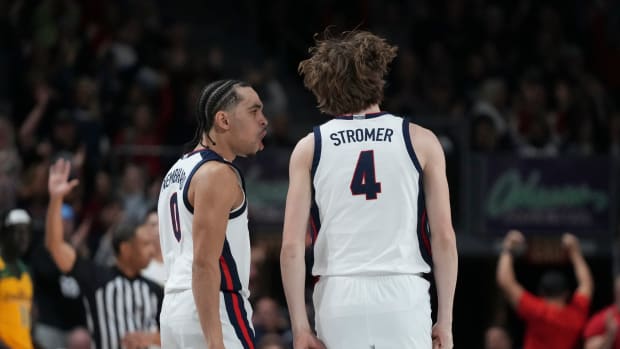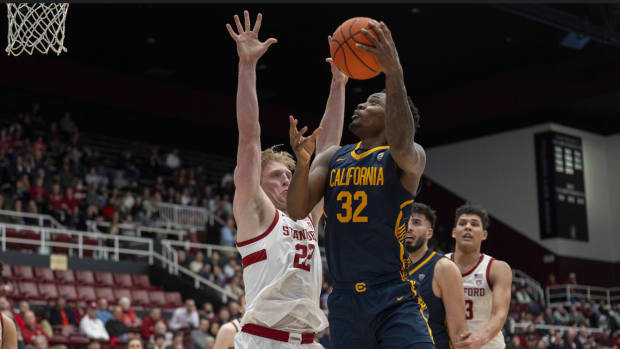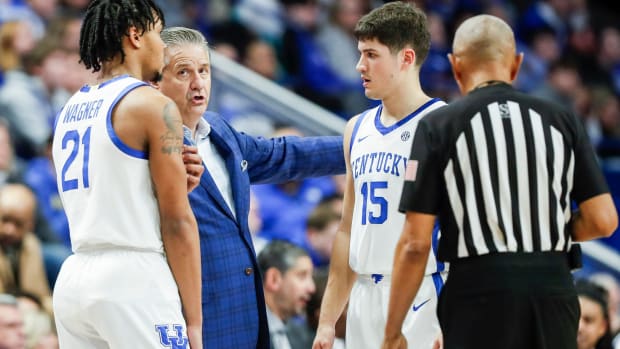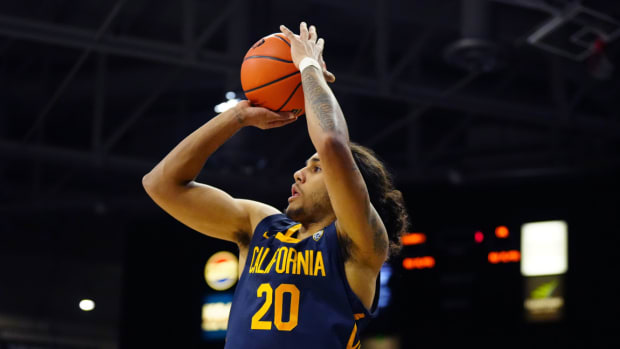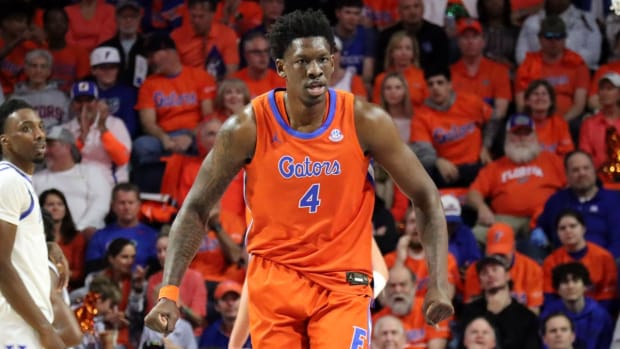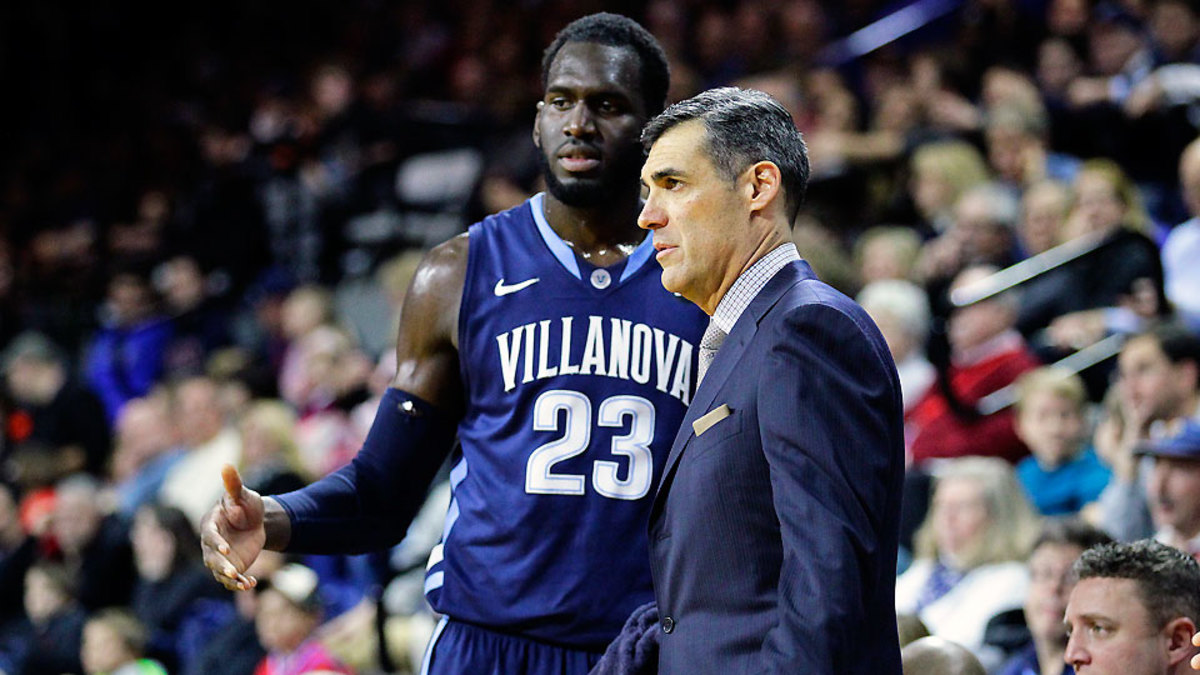
Villanova hoping improved defense can prevent early tournament exit
MILWAUKEE—The Bradley Center was perhaps not the ideal place to be last Saturday in pursuit of evidence that Villanova has the sort of defense that will serve as a failsafe against cold shooting in March. In an 87-76 win over a severely undermanned Marquette team, the Wildcats never seemed truly uncomfortable. But the Golden Eagles, riding six healthy scholarship players, shot 55% on two-point attempts and hoisted 25 free throws. It was the first time in seven games that a Villanova opponent cracked the 70-point mark.
The execution was good enough to get by. It fell short, though, of good enough to get a top 10 club where it wants to go in March.
So as Jay Wright walked through a tunnel toward the coaches’ locker room afterward, he paused when asked if this was his best defensive team in memory. With the mild frustrations of this game still fresh in mind, the Wildcats’ 14th year coach took a guarded stance.
“We’re getting there,” Wright said. “We’re just getting there. We’re a different kind of defensive team. That’s why I hesitate—I don’t know if it’s our best, but it’s our most solid.”
• MORE CBB: Villanova a No. 2 seed in our latest NCAA tournament bracket
Villanova is 25-2 and ranked first place in the Big East. And again, a balanced (six players average between 9 and 14.4 points per game), potent offense reliant on three-point proficiency is its defining characteristic. But as March approaches, the dull ache of going five straight years without reaching the second weekend of the NCAA tournament lingers. With it comes the worry about what will happen when the shots don’t fall, and for that the Wildcats are verging on a viable answer: They’ll just make sure the other team misses more.
As of Monday, Villanova ranked 23rd nationally in adjusted defensive efficiency (92.7), per kenpom.com. They finished 16th a year ago, when they fell to eventual national champion Connecticut in the Round of 32. But last year’s efficiency figure was actually a touch worse (94.5). The raw points per possession number is also down from last year to this one (0.849 to 0.792, per Synergy Sports). And analysis of individual defenders support Wright’s assessment that this roster is more reliable.
Six of Villanova’s eight primary rotation players rank in the 72nd percentile or better as individual point-per-possession defenders, per Synergy data. (This places them in the “very good” range.) Only three regulars surpassed that number last season. In 2014-15, Villanova essentially has interchangeable defenders without as much drop-off when they interchange. “Guys can guard multiple positions,” senior guard Darrun Hilliard said. “Daniel (Ochefu) can guard one through five, so can JayVaughn (Pinkston). I think that just makes us special. We don’t have a guy who can’t guard anyone on the floor.”
Hoop Thoughts: Dispelling Selection Sunday myths as tourney draws near
It’s an exaggeration—it’s doubtful Wright and his staff would shrug off 6’3” point guard Ryan Arcidiacono switching on to an opposing center—but the more general point holds. “We don’t have a huge team,” Wright says, “but we have overall good team length.” Hilliard is a 6’6” shooting guard. Pinkston is a 6’7” Swiss army knife. Kris Jenkins and Josh Hart are 6’6” and 6’5” wings, respectively. The 6’11” Ochefu is the backstop; his defensive rating of 85.6 is the best of his career. Kentucky, they’re not, but they don’t have to be. Villanova only needs enough size and athleticism to be flexible with matchups and to be bothersome when the personnel is deployed correctly.
That last bit, Wright evidently settled on just last month. Some of his past teams have pressured consistently, and he tried the same tack with this one for a good part of the season. Then came the Georgetown game on Jan. 19. “They sliced us,” Wright said, recalling a 78-58 thrashing in which the Hoyas shot 51%. He and his staff concluded there were too many good passing teams in the Big East to risk opening the floor.
So they stacked up those long defenders in the half-court, and Villanova subsequently held five of its next seven opponents to scores in the 50s. Pressure is still in the toolbox; the Wildcats deployed a three-quarter court diamond zone press at Marquette in short spurts to decent effect. (“We still do press, but we’re more discreet and smart with it,” Hilliard said.) Still, the foundation moving ahead will be even less complex than that.
“We have to get a little tougher, a little more nasty on the defensive end,” Hilliard said, “but it’s just staying in the half-court and digging in and grinding.”
It is a team now getting very comfortable with a new style.
“The key is when you can define who you are, that’s good,” Wright said. “When I don’t like it is when you’re in between and you’re not good at either. You’re not creating enough turnovers to be a really aggressive, pressing team, and you’re not solid enough. When you’re caught in between, you’re usually not a good team.”
Even the results at Marquette featured an explanation or an excuse, depending on your perspective. Villanova prepared to see the Golden Eagles’ leading scorer, Matt Carlino, who had missed the previous three games recovering from a concussion. The fifth-year sharpshooter didn’t play, though, because he hadn’t yet passed post-concussion protocols. Without him, Marquette became almost exclusively a dribble-drive-and-kick offense, which was not what the Wildcats expected.
Fans, players, legends pay tribute to North Carolina's Dean Smith
Then again, disciplined defensive play should limit the effectiveness of such an attack. Which is why Wright deemed Saturday a “little bit” of a setback, and why Arcidiacono conceded it “wasn’t our best effort.” It seemed more exception than rule, though, and it must remain so for Villanova to reverse its March fortunes.
As of Monday, 41.7% of Villanova’s field goal attempts were three-pointers, the 31st highest rate in all the land. Restrict it to the Power Five conferences plus the AAC, Big East and Atlantic-10, though, and the Wildcats rank fifth in reliance on long-range bombs.
The Wildcats likely will be more prone to offensive detonation—good or bad—than the teams in their way of a Sweet 16 bid. Last year the Wildcats missed 15-of-19 three-point attempts in an upset loss to Seton Hall in the Big East tournament, and though they hit 11 threes against Connecticut in the NCAA tournament, they couldn't survive 35.5% shooting overall that night. If the team is less prone to defensive implosion, the offensive swing might matter less.
“Last year, we played some solid defense, but this year we’ve been really turning it up,” Arcidiacono said. “We’ve won some games this year where we’ve played pretty bad offensively but our defense has always been there. It’s a great feeling to have.”
That's fine for now. It's the feeling in March the Wildcats aim to change.
